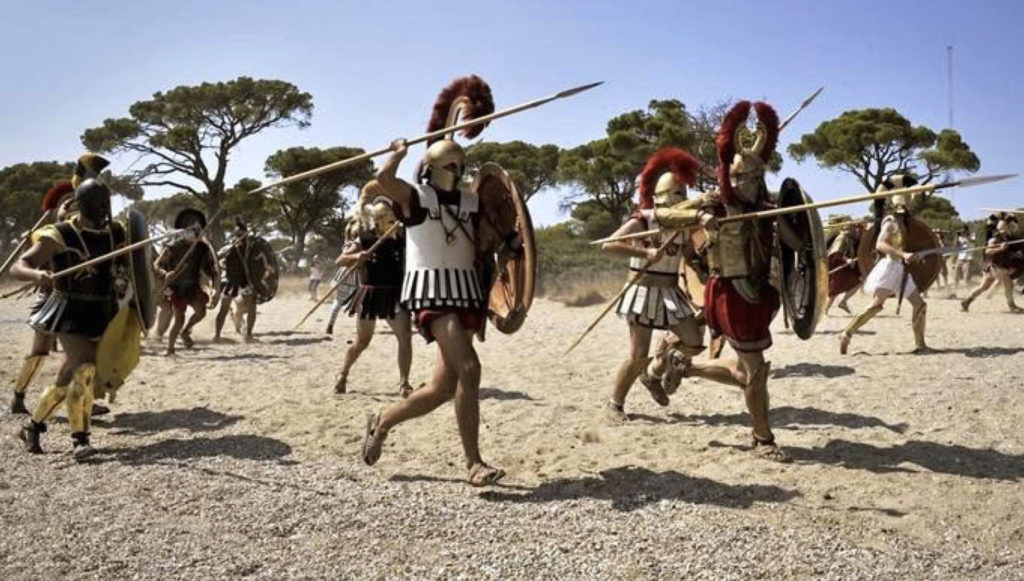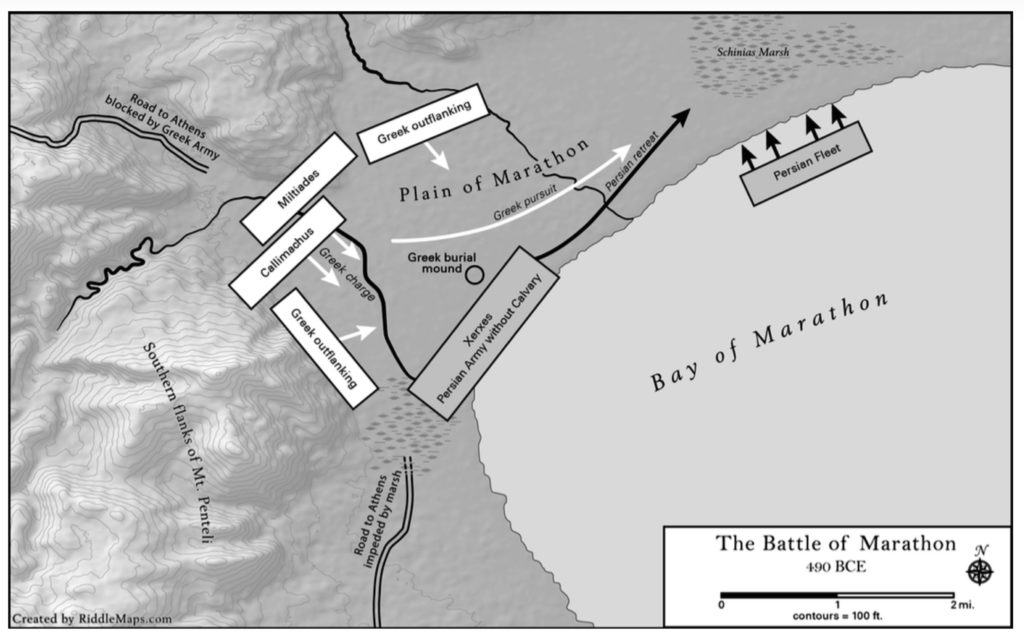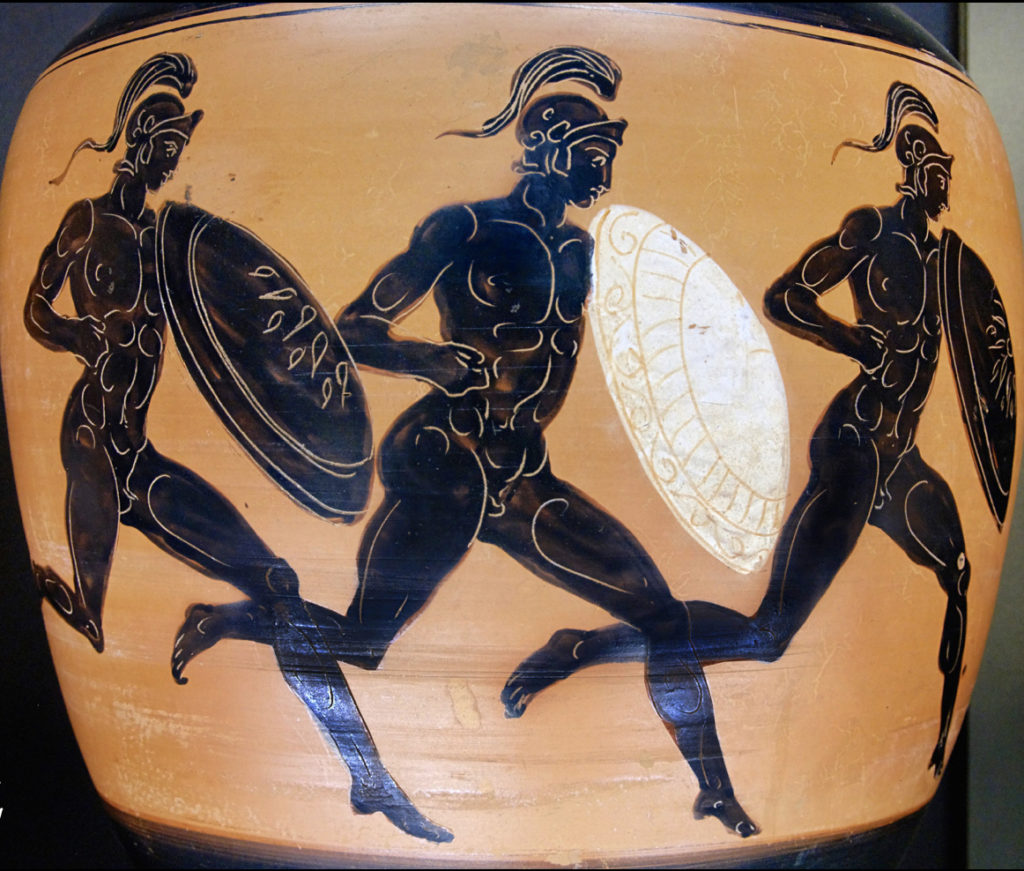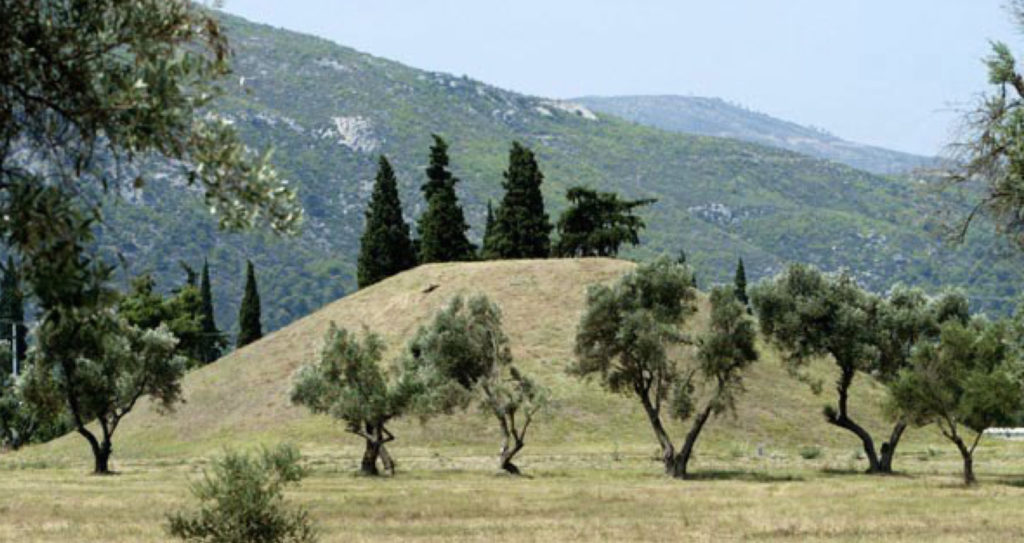
By Adrian Arima and Jeff Richardson –
The battle at Marathon between the Greeks and Persians was one of the most pivotal battles in history, basically enabling the continued birth and evolution of Western civilization. The Greek charge took the Persians by surprise, and, whether or not they outnumbered the Greeks, they never recovered from their initial confusion and suffered a resounding defeat. [1]
An interesting question is how long did the Persians have before the Greeks were initially upon them? The generally accepted distance of the charge is about 1 mile [1] [2], certainly more for the left flanking wing, possibly a little less for the right flanking wing, but the wings probably temporally lagged the center engagement (Figure 1). One of us did some checking on Google maps and a topographical website [3]; you can click anywhere on the topographical map and get the elevation. We assume that the Greeks would have erected the tumulus for their dead on approximately the spot where most of them died – i.e., the scene of the main battle front. The tumulus could be uphill from where the battle first began, if the Greeks were pushed back by the Persian middle as Herodotus described. Looking uphill from the tumulus, it is approximately a mile (or a little less) up to an area in front of the foot of the mountains where the Greeks could have camped. This is approximately the distance that Herodotus specified, assuming he might have exaggerated a bit. It seems to us the elevation drop is about 40 feet over that distance as the Greeks raced downhill, or slightly less than a 1% grade on average.

How long would it take to run a mile in armor? And how much armor? And what was the running strategy? The modern world record is 3:43, flat track, no wind, no obstacles, Nike shoes, shorts and tank-top, and the runners are exquisitely trained for this specific event. What did the Greek hoplites wear? Sandals, greaves, some form of cuirass or breastplate of bronze or linoathorax, helmet, shield, sword and spear – maybe 50 pounds in all, maybe a little less for the average farmer hoplite. Because of the existential threat, the Greek army was probably the result of a call for “all hands on deck” – young men, farmers, merchants, sailors, shepherds, middle-aged men (e.g., Aeschylus was 35 and had been a playwright for about 10 years). The army surely had a distribution of physical fitness – farmers were certainly strong, but not aerobically trained (aerobic training requires multiple sessions per week), men like Aeschylus probably less so, men who competed in the hoplitodomos probably more so. It is interesting to consider the hoplitodomos event [5] – usually abbreviated armor (helmet, greaves and shield) and initially a shorter distance (about a ¼ mile in Athens, about the distance of a Persian arrow); challenging, but not a mile in full armor over broken ground, and not the standard the entire army could be expected to meet. There is no reason to expect that any of the armored Greeks would have reached the Persians after covering a mile in anything approaching current world record time.

One of us has and does run extensively (hundreds of 10K races, half of which are trail runs, a few marathons, and a bunch of half-marathons). What might have it been like, to be one of the Greek hoplites, when Miltiades said GO? A list of observations, based on anecdotal experience: 1) depending on how close you are to the front, which partly depends on how deep and wide the Greek formation was, initially nothing happens unless you are in the front row. It can easily take 30-60 seconds in a large race (or in successive waves in a really large race, which, by the way, can easily be about the size of the Greek army), before you reach the start line (that’s why races now use chip timing instead of gun timing) Even for only a few rows deep, a few seconds are lost while everyone starts moving. 2) the first mile is always the slowest, because your entire attention is focused on your feet and the feet of runners near you – to tumble in the start sets off a chain reaction of falling bowling pins. In a trail run you have bushes, roots, rocks, logs, etc. to avoid as well – this is not a track race! 3) running with weight is incredibly difficult, easier for the muscular forms no doubt, but they will be by definition the slower runners (and anyone who has gone through military basic training can identify with the modern difficulty of running in a group, with a helmet, pack and rifle); 4) running while carrying things greatly impedes running, leading to upper body aches and restrictions in breathing; 5) running down a 1% grade is certainly better than running up a grade, but 1% is so little that it feels like the effort is reduced but the speed is not proportionately augmented by the grade (as opposed to a steeper grade, where the goal is to move your feet ever faster to keep up with your body); 6) looking at current day reenactment scenes suggest, besides uneven terrain (i.e., like a trail run previously described) the potential presence of sand. Running fast in dry sand is impossible, for anyone and everyone. Finally, anyone, world-class miler to weekend jogger, if they push hard for a mile will find themselves sucking wind at the end, bent over and barely able to move. Hardly ready to engage the Persians. To avoid quickly reaching the Persians and then being slain immediately, even by unprepared foes because you are bent over and immobile, means you need a run strategy. Every runner, except for sprinters, paces himself, usually to pick up the pace for the finish, or, in the case of the Greek hoplites, to have enough left to engage the Persians while 1) you recover your second wind, and 2) the rest of the Greek charge catches up to the front (the distribution of arrival times can’t be too broad in order to have an initial, forceful shock assault – the hoplitodomos winner is going to get there well before Aeschylus!). The straightforward way to pace yourself is to run slower. Considering all the factors we’ve discussed, it appears unlikely that any significant number of Greeks in the main, central charge reached the Persians in less than 10 minutes if they were running a mile. The majority of the Greeks, including the flanking wings, probably arrived in 10-15 minutes. An interesting experiment to demonstrate that suggestion would be to place a sub-4 minute miler, dressed out in full hoplite armor, in the middle of a few thousand Greek high school students with 30-50 pound backpacks, in whatever formation the Greek hoplites had assumed, and see how long it takes them and him to reach the beach at Marathon after running a mile. While the Persians may have been surprised, 10 or more minutes implies either that the Persian pickets were exceptionally inattentive, or the Greeks didn’t charge the entire mile.

If the Greeks could have used natural cover to conceal their approach to the Persians, they would both shorten the time, tighten the temporal distribution of the assault, and decrease the tax on their stamina. Romantic paintings of the battle show armies clashing on a treeless plain, but that may not have been realistic. Using Google Maps in the street-view mode, there are a lot of small trees in the area today. Mostly these are cultivated olive and fruit trees but if you look at the open spaces, there are groves of small trees which look like grey oaks similar to the California live oaks in the San Francisco Bay Area. A modern battle recreation shows costumed Greeks running out onto the beach with trees behind them. The battle occurred in August or September so even deciduous trees would have retained their leaves. The rainfall in modern Greece is roughly the same as in the ancient period. [6] It is certainly possible that the area could have been more forested than it is now, due to recent deforestation as the population increased: “There were more extensive forests in classical times than at present, an estimate based on the evidence of archaeology, paleobotany, and ancient writings.” [7] Our hypothesis is that there was an area of trees between the Greek and Persian camps. It is suggested that the Greek camp could have been protected by a grove of trees. [8] [9] Over a distance of a mile, even widely spaced trees would have concealed the Greeks from the Persians. The Greeks waited a few days before attacking the Persians. Although historians say this was so they could attack on the day that Miltiades’ rotation as president came up, it seems to us that a small army intending to attack a much larger foe would have spent the time planning how they would do that. This would have included scouting out the Persian positions, including Persian guard posts in the forests positioned to detect Greek advances. Scouts could have determined the timing of the changing of the Persian guards, and on the day of attack the Greeks could have dispatched “commando” teams to neutralize that Persian guard posts, thus allowing the Greeks to walk (not run) through at least a portion of the trees and then commence a surprise attack on the Persians from a shorter distance. Even if some Persian guard posts were able to send messengers back, the reports would have been scattered and it would have been unclear where the Greek attack was coming from. Tree cover might also have neutralized, to some extent, the Persian archery advantage and possibly explain why Persian cavalry was not deployed (since they would have been less effective with trees in the way). In this scenario, it would have been only a matter of a few minutes, perhaps as little as 5 minutes, before the bulk of the Greek army was attacking the Persians, ultimately on 3 sides, and the rout was on.
An alternative scenario of the battle is laid out in the Ancient History Encyclopedia (the “AHE” article). [4] The AHE article posits that the Persians were not surprised but instead lined up for battle with the usual preparation, except the cavalry was absent. The forces stretched out over 1,500 meters. The article says the Greeks initially lined up 8 men deep along the line, but as it stretched out, they had to go to 4-man deep. So this would greatly minimize the “back of the pack” time delay mentioned above. One issue with this description is that the math doesn’t quite line up: if you assume the men stand about one meter apart, then spreading 10,000 Greeks along 1,500 meters calculates out to 6 or 7 men deep. In any event, it seems logical to us that in the above scenario, the Greeks would have to stretch out a continuous line so as not to leave gaps and that the line had to stretch out to protect the flanks. There would still be the issue of some Greeks being fit & faster and others not being able to keep up, especially if they had to also trot out to the far flank first. On the other hand, running a shorter distance means a tighter arrival time distribution.
The AHE and other articles (e.g.,[8]) speculate why the Greeks attacked rather than waited for the Spartans to arrive, which would have greatly bolstered their chances of success. Maybe it was because the Persians were preparing to attack anyway and the Greeks thought they stood a better chance striking first. Our theory is that the Persians’ master plan was to lure the Athenian army out to Marathon and engage them with some ground forces, while the cavalry and other troops re-boarded the ships and set sail to attack an undefended Athens from the sea. The Greeks, seeing the cavalry re-boarding the boats realized what was happening and attacked quickly so they could regroup and return to defend Athens. Also, they could take advantage of the absence of the Persian cavalry. This would also imply that the number of Persians left on the battlefield might have been a lot less than the total manpower of the army (the AHE article says only 1/2 the army was on the ground). And maybe these forces, being intended only as a diversion, were the more inexperienced troops, more lightly armed and maybe lacking the Persian elite corps.
We are unconvinced the 1500 meter-long-line scenario is correct. It plays to the Greek’s weaknesses — inferior numbers to the Persians and decreased mobility of heavily armored Greeks vs more lightly armed Persians — and abandons the Greek main battle tactic, the concentrated phalanx. This would look like an unattractive proposition for the Greeks. Our inclination is that the Greeks understood this and would use something like the slinking-through-the-forest tactic (or starting in early morning darkness) for an element of surprise. This would enable them to concentrate their meager forces into phalanxes that could stand up to thick Persian lines. With little time to organize, the Persians would not have been able to deploy flanking troops and would be forced into countering the immediate threat of a heavily armored Greek force with a mass of lighter Persian troops. And one would think that only a surprise attack would enable the greatly outnumbered Greeks to outflank the large Persian army. The Greeks wouldn’t need complete surprise, just a big enough head start in organizing and approaching the battle so that the Persians wouldn’t have enough time to organize a broad deployment of their troops.
The AHE article states that the Greeks probably ran only the last 400 meters, as that is the approximate range of Persian arrows, and that the Persian forces charged towards the Greeks thus closing the distance between them. So the distance the Greeks would have run with their heavy battle regalia could have been considerably less than the one mile suggested by Herodotus, and even less than the initial 400 meters if the Persians were not surprised and were also charging. Maybe Western Civilization was saved not by a marathon, but by a sprint.
Notes
[1] Patrick Hunt, When Empires Clash (2016, ISBN-13: 978-1942614128), Chapter 3.
[2] Peter Krentz, The Battle of Marathon (2010, ISBN-13: 978-0300120851)
[3] https://elevation.maplogs.com/poi/marathon_greece.103562.html
[4] https://www.ancient.eu/marathon/
[5] Waldo E. Sweet, Sport and Recreation in Ancient Greece (1987, ISBN-13: 978-0195041262), pg. 4
[7] The Oxford Encyclopedia of Ancient Greece and Rome, p.71. https://books.google.com/books?id=lNV6-HsUppsC&pg=RA2-PA71&lpg=RA2-PA71&dq=forestation+ancient+greece&source=bl&ots=QpIOrTeAyI&sig=ACfU3U0vWIYKdC16iskj54rm2fmRCC4ZZw&hl=en&sa=X&ved=2ahUKEwjXi7KwuITpAhVVip4KHb6MBok4FBDoATAFegQIDBAB#v=onepage&q=forestation%20ancient%20greece&f=false.
[8] Cornelius Nepos, Lives of Eminent Commanders (1886), Miltiades V. (www.tertullian.org/fathers/nepos.htm)
[9] J.F. Lazenby, The Defence of Greece: 490-479 BC (Aris and Phillips Classical Texts, 1993, ISBN-13: 978-0856685910)
Note: this article comes out of a Stanford postgraduate course CLA 131 Ten Great Ancient Battles, spring 2020.